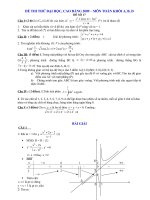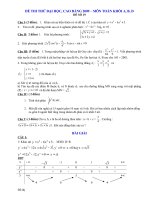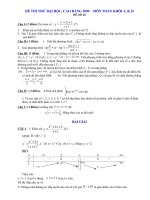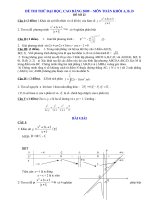Đề và ĐA T.Anh K_D ĐH 2009
Bạn đang xem bản rút gọn của tài liệu. Xem và tải ngay bản đầy đủ của tài liệu tại đây (208.2 KB, 10 trang )
BỘ GIÁO DỤC VÀ ĐÀO TẠO
ĐỀ CHÍNH
THỨC
(Đề thi có 06 trang)
ĐỀ THI TUYỂN SINH ĐẠI HỌC NĂM 2009
Môn: TIẾNG ANH; Khối: D
Thời gian làm bài: 90 phút, không kể thời gian phát đề
Mã đề thi 174
Họ, tên thí sinh:.......................................................................
Số báo danh:............................................................................
ĐỀ THI GỒM 80 CÂU (TỪ QUESTION 1 ĐẾN QUESTION 80)
Read the following passage and mark the letter A, B, C, or D on your answer sheet to indicate the
correct answer to each of the questions from 1 to 10.
Probably the most famous film commenting on the twentieth-century technology is Modern Times,
made in 1936. Charlie Chaplin was motivated to make the film by a reporter who, while interviewing
him, happened to describe the working conditions in industrial Detroit. Chaplin was told that healthy
young farm boys were lured to the city to work on automotive assembly lines. Within four or five years,
these young men’s health was destroyed by the stress of work in the factories.
The film opens with a shot of a mass of sheep making their way down a crowded ramp.
Abruptly, the film shifts to a scene of factory workers jostling one another on their way to a factory.
However, the rather bitter note of criticism in the implied comparison is not sustained. It is replaced by
a gentle note of satire. Chaplin prefers to entertain rather than lecture.
Scenes of factory interiors account for only about one-third of Modern Times, but they contain
some of the most pointed social commentary as well as the most comic situations. No one who has seen
the film can ever forget Chaplin vainly trying to keep pace with the fast-moving conveyor belt, almost
losing his mind in the process. Another popular scene involves an automatic feeding machine brought to
the assembly line so that workers need not interrupt their labor to eat. The feeding machine
malfunctions, hurling food at Chaplin, who is strapped in his position on the assembly line and cannot
escape. This serves to illustrate people’s utter helplessness in the face of machines that are meant to
serve their basic needs.
Clearly, Modern Times has its faults, but it remains the best film treating technology within a
social context. It does not offer a radical social message, but it does accurately reflect the sentiment of
many who feel they are victims of an over-mechanised world.
Question 1: According to the passage, Chaplin got the idea for Modern Times from .
A. a conversation B. a movie C. fieldwork D. a newspaper
Question 2: The young farm boys went to the city because they were .
A. attracted by the prospect of a better life B. forced to leave their sheep farm
C. promised better accommodation D. driven out of their sheep farm
Question 3: The phrase “jostling one another” in the third paragraph is closest in meaning to
“ ”.
A. running against each other B. pushing one another
C. hurrying up together D. jogging side by side
Question 4: According to the passage, the opening scene of the film is intended .
A. to reveal the situation of the factory workers B. to produce a tacit association
C. to introduce the main characters of the film D. to give the setting for the entire plot later
Question 5: The word “vainly” in the fourth paragraph is closest in meaning to “ ”.
A. effortlessly B. recklessly C. hopelessly D. carelessly
Question 6: The word “This” in the fourth paragraph refers to .
A. the situation of young workers in a factory
B. the scene of an assembly line in operation
C. the scene of the malfunction of the feeding machine
D. the malfunction of the twentieth-century technology
Trang 1/6 - Mã đề thi
174
Question 7: According to the author, about two-thirds of Modern Times .
A. is more critical than the rest B. is rather discouraging
C. was shot outside a factory D. entertains the audience most
Question 8: The author refers to all of the following notions to describe Modern Times EXCEPT
“ ”.
A. entertainment B. satire C. criticism D. revolution
Question 9: Which of the following statements is NOT true according to the passage?
A. The working conditions in the car factories of the 1930s were very stressful.
B. The author does not consider Modern Times as a perfect film.
C. Modern Times depicts the over-mechanised world from a social viewpoint.
D. In Modern Times, the factory workers’ basic needs are well met.
Question 10: The passage was written to .
A. review one of Chaplin’s popular films B. explain Chaplin’s style of acting
C. discuss the disadvantages of technology D. criticize the factory system of the 1930s
Read the following passage and mark the letter A, B, C, or D on your answer sheet to indicate the
correct answer to each of the questions from 11 to 20.
Very few people in the modern world obtain their food supply by hunting and gathering in the natural
environment surrounding their homes. This method of harvesting from nature’s provision is the oldest
known subsistence strategy and has been practised for at least the last two million years. It was, indeed,
the only way to obtain food until rudimentary farming and the domestication of wild animals were
introduced about 10,000 years ago.
Because hunter-gatherers have fared poorly in comparison with their agricultural cousins, their
numbers have dwindled, and they have been forced to live in marginal environments, such as deserts
and arctic wastelands. In higher latitudes, the shorter growing seasons have restricted the availability of
plant life. Such conditions have caused a greater dependence on hunting, and on fishing along the coasts
and waterways. The abundance of vegetation in the lower latitudes of the tropics, on the other hand, has
provided a greater opportunity for gathering a variety of plants. In short, the environmental differences
have restricted the diet and have limited possibilities for the development of subsistence societies.
Contemporary hunter-gatherers may help us understand our prehistoric ancestors. We know from the
observation of modern hunter-gatherers in both Africa and Alaska that a society based on hunting and
gathering must be very mobile. While the entire community camps in a central location, a smaller party
harvests the food within a reasonable distance from the camp. When the food in the area has become
exhausted, the community moves on to exploit another site. We also notice seasonal migration
patterns evolving for most hunter-gatherers, along with a strict division of labor between the sexes.
These patterns of behavior may be similar to those practised by mankind during the Paleolithic Period.
Question 11: The word “domestication” in the first paragraph mostly means .
A. adapting animals to suit a new working environment
B. hatching and raising new species of wild animals in the home
C. teaching animals to do a particular job or activity in the home
D. making wild animals used to living with and working for humans
Question 12: According to the passage, subsistence societies depend mainly on .
A. hunter-gatherers’ tools B. nature’s provision
C. farming methods D. agricultural products
Question 13: The word “marginal” in the second paragraph is closest in meaning to “ ”.
A. disadvantaged B. suburban C. forgotten D. abandoned
Question 14: In the lower latitudes of the tropics, hunter-gatherers .
A. can free themselves from hunting B. have better food gathering from nature
C. live along the coasts and waterways for fishing D. harvest shorter seasonal crops
Trang 2/6 - Mã đề thi
174
Question 15: According to the passage, studies of contemporary subsistence societies can provide a
.
A. further understanding of prehistoric times
B. broader vision of prehistoric natural environments
C. further understanding of modern subsistence societies
D. deeper insight into the dry-land farming
Question 16: The word “conditions” in the second paragraph refers to .
A. the places where plenty of animals and fish can be found
B. the situations in which hunter-gatherers can grow some crops
C. the environments where it is not favorable for vegetation to grow
D. the situations in which hunter-gatherers hardly find anything to eat
Question 17: A typical feature of both modern and prehistoric hunter-gatherers is that .
A. they live in the forests for all their life
B. they don’t have a healthy and balanced diet C.
they don’t have a strong sense of community D.
they often change their living places
Question 18: According to the passage, which of the following is NOT mentioned?
A. Harvesting from the natural environment had existed long before farming was taken up.
B. The environmental differences produce no effect on subsistence societies.
C. The number of hunter-gatherers decreases where farming is convenient. D.
Hunting or fishing develops where there are no or short growing seasons.
Question 19: According to the author, most contemporary and prehistoric hunter-gatherers share
.
A. some methods of production B. some patterns of behavior
C. some restricted daily rules D. only the way of duty division
Question 20: Which of the following would serve as the best title of the passage?
A. Hunter-gatherers and Subsistence Societies B. Evolution of Humans’ Farming Methods
C. A Brief History of Subsistence Farming D. Hunter-gatherers: Always on the Move
Mark the letter A, B, C, or D on your answer sheet to show the underlined part that needs
correction.
Question 21: Found in the 12
th
century, Oxford University ranks among the world’s oldest universities.
A B C D
Question 22: Bill was a b out ave r age in performance in comparison with other students in his class.
A B C D
Question 23: Even though the extre m ely bad weather in the mountains, the climbers decided
A B
not to ca n cel their cli m b .
C D
Question 24: The media hav e produced live cove r in g of Michael Jackson’s f a ns a r ound t h e world
A B C
mourn i ng for h i m .
D
Question 25: Although smokers are aware that smoking is harmful to their health, they can’t g et r i d it .
A B C D
Mark the letter A, B, C, or D on your answer sheet to indicate the word that differs from the rest in
the position of the main stress in each of the following questions.
Question 26: A. elephant B. dinosaur C. buffalo D. mosquito
Question 27: A. abnormal B. initial C. innocent D. impatient
Question 28: A. significant B. convenient C. fashionable D. traditional
Question 29: A. catastrophe B. agriculture C. dictionary D. supervisor
Trang 3/6 - Mã đề thi
174
Question 30: A. settle B. protect C. compose D. relate
Read the following passage and mark the letter A, B, C or D on your answer sheet to indicate the
correct word for each of the blanks from 31 to 40.
Some time ago, scientists began experiments to find out (31)
a “village” under the sea. A special room was built and lowered (32)
it would be possible to set up
the water of Port Sudan
in the Red Sea. For 29 days, five men lived (33) a depth of 40 feet. At a (34) lower
level, another two divers stayed for a week in a smaller “house”. On returning to the surface, the men
said that they had experienced no difficulty in breathing and had (35)
many interesting
scientific observations. The captain of the party, Commander Cousteau, spoke of the possibility of
(36)
the seabed. He said that some permanent stations were to be set up under the sea, and
some undersea farms would provide food for the growing population of the world.
The divers in both “houses” spent most of their time (37)
the bottom of the sea. On four
occasions, they went down to 360 feet and observed many extraordinary (38)
of the marine
life, some of which had never been seen before. During their stay, Commander Cousteau and his
divers reached a depth of 1,000 feet and witnessed a gathering of an immense (39)
which numbered, perhaps, hundreds of millions. They also found out that it was (40)
rapidly in the water in a special vessel known as a “diving saucer”.
of crabs
to move
Question 31: A. how B. which C. what D. whether
Question 32: A. underneath B. down C. below D. into
Question 33: A. at B. in C. from D. on
Question 34: A. more B. any C. much D. some
Question 35: A. caught B. done C. made D. exercised
Question 36: A. implanting B. transplanting C. growing D. cultivating
Question 37: A. enquiring B. imploring C. exploring D. inquiring
Question 38: A. breeds B. forms C. systems D. castes
Question 39: A. herd B. flock C. school D. pack
Question 40: A. hardly B. able C. possible D. capable
Mark the letter A, B, C, or D on your answer sheet to indicate the correct answer to each of the
following questions.
Question 41: There should be an international law against .
A. afforestation B. deforestation C. forestry D. reforestation
Question 42: “I’d rather you
home now.”
A. going B. go C. gone D. went
Question 43: “Don’t worry. I have
tire at the back of my car.”
A. another B. other C. others D. the other
Question 44:
he arrived at the bus stop when the bus came.
A. No longer has B. No sooner had C. Not until had D. Hardly had
Question 45: Susan’s doctor insists
for a few days.
A. that she is resting B. her resting C. that she rest D. her to rest
Question 46: We couldn’t fly
because all the tickets had been sold out.
A. economical B. economy C. economic D. economics
Question 47: Through an
, your letter was left unanswered.
A. overtone B. overcharge C. overtime D. oversight
Question 48: – “Mum, I’ve got 600 on the TOEFL test.”
– “ ”
A. Good way! B. You are right. C. Oh, hard luck! D. Good job!
Question 49: Jane
law for four years now at Harvard.
A. is studying B. has been studying C. studies D. studied
Trang 4/6 - Mã đề thi
174









